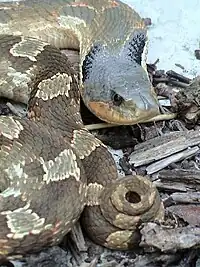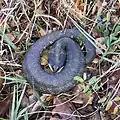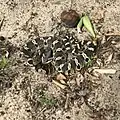| Eastern hognose snake | |
|---|---|
 | |
| Eastern hog-nosed snake (southern Georgia morph) | |
| Scientific classification | |
| Domain: | Eukaryota |
| Kingdom: | Animalia |
| Phylum: | Chordata |
| Class: | Reptilia |
| Order: | Squamata |
| Suborder: | Serpentes |
| Family: | Colubridae |
| Genus: | Heterodon |
| Species: | H. platirhinos |
| Binomial name | |
| Heterodon platirhinos | |
| Synonyms[2] | |
| |
The eastern hog-nosed snake[3] (Heterodon platirhinos), is a species of mildly venomous rear-fanged snake in the family Colubridae. The species is endemic to North America.[4] There are no subspecies that are recognized as being valid.[3] This species prefers habitats with sandy soils and a combination of grass fields and forest edges.[5] They come in many different colorations and have the identifiable upturned "snout".[6] They can be found in captivity but are a more difficult species to keep due to a specialized diet of toads.
Geographic range
H.platirhinos have a wide geographical range from the central United States to the east coast. In the northern parts of their range they can be found in southern Ontario, southern New Hampshire, Minnesota, and Wisconsin. Going west the snake can be found in Texas and Kansas. The southern part of their range then goes down into southern Florida.[7]
Habitat
Studies have shown that H. platirhinos prefers upland sandy pine-forests, old-fields and forest edges.[8] Like most of the genus Heterodon, the Eastern Hognose Snake prefers dry conditions with loose soil for burrowing purposes.[9] These loose soils are preferable habitat components for nesting and egg laying.[10] At the northern end of their range, they have been found to prefer developed lands as their desired habitat followed by mixed forests dominated by hemlock trees.[11] Based on a study in Canada, the average home range size is about 40 hectares.[8] Their habitats include southeastern and midwestern woodlands, tall-grassland prairies, and grassy or cultivated fields along woodland edges.[12][6]
Description and etymology




_2.jpg.webp)
The generic name Heterodon is derived from the Greek words heteros meaning "different" and odon meaning "tooth". The specific name platirhinos is derived from the Greek words platys meaning "broad or flat" and rhinos meaning "snout".[13] The color pattern of this snake is extremely variable. It can be red, green, orange, brown, gray to black, or any combination thereof depending on locality. Dorsally, it can be blotched, checkered, or patternless. The belly tends to be a solid gray, yellow, or cream-colored. In this species the underside of the tail is lighter than the belly.[14] The most distinguishing feature is the upturned snout, used for digging in sandy soils.[6] The average adult H. platirhinos measures 71 cm (28 in) in total length (including tail), with females being larger than males. The maximum recorded total length is 116 cm (46 in).[15]
Common names
Common names for H. platirhinos include eastern hog-nosed snake,[3] spreading adder, spread'em outer, hog-nosed snake, adder, bastard rattlesnake, black adder, black blowing viper, black hog-nosed snake, black viper snake, blauser, blower, blowing adder, blowing snake, blow(ing) viper, blow snake, buckwheat-nose snake, calico snake, checkered adder, checkered adder, chunk head, common hog-nosed snake, common spreading adder, deaf adder, eastern hognose snake, flat-head, flat-head(ed) adder, hay-nose snake, hissing adder, hissing snake, hog-nosed adder, hog-nosed rattler, hog-nose snake, hog-nosed viper, hissing viper, (mountain) moccasin, North American adder, North American hog-nosed snake, pilot, poison viper, puff(ing) adder, red snake, rock adder, rossel bastard, sand adder, sand viper, spotted (spreading) adder, spread nelly, spread-head moccasin, spread-head snake, spread-head viper, flat-head adder (spreading) viper.[16]
Behavior
The Eastern hognose is a diurnal species.[6] It is typically most active during April–September after coming out of hibernation. Because there is such a wide range the snake is found there is variation in the population's climates which can cause the period of activity to change. In northern climates, hibernation comes earlier and begins late September–October whereas in southern climates, the snake might not retreat until November. There have been some recorded to still be active between December–February in Florida and along the Gulf Coast.[5] If the temperature reaches or drops below 19 degrees Celsius, hibernation will begin for the snake. This hibernation period takes place alone in burrows either dug by the snake or already made mammal burrows. To burrow, a snake forces its head into the soil then moves its head back and forth. For hibernation, these burrows will reach depths of 25 centimeters or more.[6]
Defensive Behavior
When the eastern hognose snake is threatened, the neck is flattened and the head is raised off the ground, like a cobra. It also hisses and will strike with its mouth closed, but it does not attempt to bite. The result can be likened to a high speed head-butt. If this threat display does not work to deter a would-be predator, an eastern hognose snake will often roll onto its back and play dead, going so far as to emit a foul musk from its cloaca and let its tongue hang out of its mouth.[14][17][18] One individual was observed playing dead for 45 minutes before reanimating and moving away.[19] This death-feigning behavior was also observed often in water habitats.[20]
Feeding
The eastern hognose snake feeds extensively on amphibians, and has a particular fondness for toads. This snake has resistance to the toxins toads secrete. This immunity is thought to come from enlarged adrenal glands which secrete large amounts of hormones to counteract the toads' powerful skin poisons. At the rear of each upper jaw, it has greatly enlarged teeth, which are neither hollow nor grooved, with which it punctures and deflates toads to be able to swallow them whole.[15][17][21] It will also consume other amphibians, such as frogs and salamanders. Because it is a toad feeding specialist, its venom has been modified to be greatly effective against toads and has not been found to be harmful to humans.[22]
Reproduction
Eastern hognose snakes mate in yearly April and May. Both the male and female snakes are known to have multiple mates during this season. Occasionally, a second breeding period occurs around September and October. Rather than fertilizing a new egg clutch at this time, females will instead store sperm until the spring months for use.[6] Males will follow the pheromone trails left behind by females on the move.[6][5] Some females have been observed traveling past viable nesting conditions in order to reach communal nesting sites.[23] Eggs might be lain in small soil depressions, mammal burrows, or under rocks depending on the region.[24] Some females have been observed traveling past viable nesting conditions in order to reach communal nesting sites.[25] The females, which lay 8–40 eggs (average about 25) in June or early July, do not take care of the eggs or young. The eggs, which measure about 33 mm × 23 mm (1+1⁄3 in × 1 in), hatch after about 60 days, from late July to September. The hatchlings are about 16.5–21 cm (6.5–8.3 in) long.[18] They have an average nest temperature of 23-26 degrees Celsius incubating for an average of 49–63 days.[10] Typically, males reach maturity at about 40 cm in length which can take up to 18-24 months. Females, however, reach maturity at about 45 cm in length, taking up to 21 months. Both of these measurements are in SVL or Snout-Vent Length.[6][5]
Venom
H. platirhinos is a mildly venomous species that's effects aren't deadly to humans.[12] Heterodon means "different tooth", which refers to the enlarged teeth at the rear of the upper jaw. These teeth inject a mild amphibian-specific venom into prey. The fangs receive the venom from the snake's Duvernoy's gland.[26] Bitten humans who are allergic to the saliva have been known to experience local swelling, burning, discoloration, and bleeding from the wounds, but no human deaths have been documented.[5]
Predators
There are many predators of the Eastern hognose snake. These include: tarantulas, other snakes, crows, red-tailed hawks, barred owls, raccoons, Virginia opossums, foxes, and humans.[6][5]
Human Impact
Humans cause pollution and pesticide poisoning, habitat destruction, vehicular deaths, and intentionally hunt the snake.[6][5] Further studies have shown that other effects humans have on the mortality of H. platirhinos come from roads. Laura E. Robson and Gabriel Blouin-Demers conducted a study and found that the Eastern hognose snake avoids crossing paved roads, increasing the isolation of populations. The snakes will cross unpaved roads but face higher mortality from vehicle collisions.[27]
Captivity
The hognose snake is an intermediate level reptile to keep and lives between 10-15 years in captivity. Typically, mice and rats are used to feed most snakes in captivity. With hognose being a toad specialist species, it can be tricky to get them to eat frozen thawed mice. Scenting the food with toad or lizard is a trick used amongst hobbyists to entice the snake. Being a solitary species, snakes are kept individually unless it is for intentional breeding. Due to their burrowing nature, hognose snakes require suitable substrate depth to retain this natural instinct.[28]
Conservation status
This species, H. platirhinos, is classified as Least Concern (LC) on the IUCN Red List of Threatened Species (Year assessed: 2007).[29] However, it is a species of increasing conservation concern, especially in the northeastern part of its range.[30][31][32][33] Of the five states in the northeast U.S. where the eastern hognose snake occurs, it currently has "listed" conservation status in four (Connecticut, New Hampshire, New York, and Rhode Island).[34] Noted declines are believed to be the result of direct anthropogenic pressures including habitat loss and fragmentation, road mortality, environmental degradation, and intentional killing.[5][35] Some of this habitat fragmentation may be due to eastern hognose snakes having a reluctance to cross paved roads.[36]
Gallery
References
- ↑ Hammerson, G.A. (2007). "Heterodon platirhinos". IUCN Red List of Threatened Species. 2007: e.T63820A12718733. doi:10.2305/IUCN.UK.2007.RLTS.T63820A12718733.en. Retrieved 19 November 2021.
- ↑ Heterodon platirhinos at the Reptarium.cz Reptile Database. Accessed 14 September 2007.
- 1 2 3 "Heterodon platirhinos". Integrated Taxonomic Information System. Retrieved 14 September 2007.
- ↑ McCoy, C.J., Jr., and A.V. Bianculli (1966). "The distribution and dispersal of Heterodon platyrhinos in Pennsylvania". Journal of the Ohio Herpetological Society 5 (4): 153-158.
- 1 2 3 4 5 6 7 8 Ernst, Carl H.; Ernst, Evelyn M. (2003). Snakes of the United States and Canada. Smithsonian Books. pp. 146–150. ISBN 1-58834-019-8.
- 1 2 3 4 5 6 7 8 9 10 Jessee, Renee. "Heterodon platirhinos (Eastern Hognose Snake)". Animal Diversity Web. Retrieved 2023-10-18.
- ↑ Behler, J.L., and F.W. King (1979). The Audubon Society Field Guide to North American Reptiles and Amphibians. New York:Alfred A. Knopf. 744 pp. (Heterodon platyrhinos pp. 614-615 + Plates 485, 563, 565).
- 1 2 Robson, Laura Elizabeth (2011). The spatial ecology of Eastern Hognose Snakes (Heterodon platirhinos): habitat selection, home range size, and the effect of roads on movement patterns (Thesis). University of Ottawa. ProQuest 1355765570 64 pp.
- ↑ Scott, David. Notes on the eastern hognose snake, Heterodon platyrhinos Latreille (Squamata: Colubridae), on a Virginia barrier island (PDF) (1st ed.). Brimleyana.
- 1 2 Cunnington, Glenn M.; Cebek, Joseph E. (2005). "Mating and nesting behavior of the eastern hognose snake (Heterodon platirhinos) in the northern portion of its range". The American Midland Naturalist. 154 (2): 474–478. doi:10.1674/0003-0031(2005)154[0474:MANBOT]2.0.CO;2. S2CID 86235429.
- ↑ Goulet; Litvaitis, J.A; Marchand, M.N (2015). "Habitat Associations of the Eastern Hognose Snake at the Northern Edge of its Geographic Distribution: Should a Remnant Population Guide Restoration?". Northeastern Naturalist. 22 (3): 530–540. doi:10.1656/045.022.0309. S2CID 86280063.
- 1 2 Tennant, Alan; Salmon, Gerard T.; King, Dr. Richard B. (2003). Snakes of North America (Revised ed.). Lanham, MD: Lone Star Books. pp. 356–359. ISBN 1-58907-003-8.
- ↑ "Eastern Hog-nosed Snake". Virginia Herpetological Society. Retrieved April 14, 2022.
- 1 2 Conant, R. (1975). A Field Guide to Reptiles and Amphibians of Eastern and Central North America, Second Edition. Boston: Houghton Mifflin. 429 pp. (Genus Heterodon and species Heterodon platyrhinos, pp. 168-170 + Plate 25 + Map 130).
- 1 2 Smith, H.M., and E.D. Brodie, Jr. (1982). Reptiles of North America: A Guide to Field Identification. New York: Golden Press. 240 pp. ISBN 0-307-13666-3. (Genus Heterodon and species Heterodon platyrhinos, pp. 164-167).
- ↑ Wright, A.H., and A.A. Wright (1957). Handbook of Snakes of the United States and Canada. (in 2 volumes). Ithaca and London: Comstock Publishing Associates, a Division of Cornell University Press. (7th printing, 1985). 1,105 pp. ISBN 0-8014-0463-0. (Heterodon platyrhinos, pp. 305-312, Figures 93-94, Map 29).
- 1 2 Goin, C.J., O.B. Goin, and G.R. Zug (1978). Introduction to Herpetology, Third Edition. San Francisco: W.H. Freeman. xi + 378 pp. ISBN 0-7167-0020-4. (Heterodon, pp. 167, 328-329).
- 1 2 Schmidt, K.P., and D.D. Davis (1941). Field Book of Snakes of the United States and Canada. New York: G.P. Putnam's Sons. 365 pp. (Heterodon contortrix, pp. 115-118, Figures 25-26 + Plate 11).
- ↑ Edgren, Richard (1955). "The Natural History of the Hog-Nosed Snakes, Genus Heterodon: A Review". Herpetologica. 11 (2): 105–117. JSTOR 3889972.
- ↑ Munyer, Edward A. (1967). "Behavior of an Eastern Hognose Snake, Heterodon platyrhinos, in Water". Copeia. 1967 (3): 668–670. doi:10.2307/1442248. ISSN 0045-8511. JSTOR 1442248.
- ↑ Boulenger, G.A. (1894). Catalogue of the Snakes in the British Museum (Natural History). Volume II., Containing the Conclusion of the Colubridæ Aglyphæ. London: Trustees of the British Museum (Natural History). (Taylor and Francis, printers). xi + 382 pp. + Plates I.- XX. (Heterodon platyrhinus, pp. 154-156).
- ↑ Cooper, William E.; Secor, Stephen (2007). "Strong Response to Anuran Chemical Cues by an Extreme Dietary Specialist, the Eastern Hog-Nosed Snake (Heterodon Platirhinos)". Canadian Journal of Zoology. 85 (5): 619–625. doi:10.1139/z07-041.
- ↑ Finn, Wendy (2005). Home Range and Spatial Ecology of Eastern Hognose Snakes (Heterodon platirhinos) (PDF). Intern report, Brookhaven National Laboratory.
- ↑ Cunnington, Glenn M.; Cebek, Joseph E. (2005). "Mating and nesting behavior of the eastern hognose snake (Heterodon platirhinos) in the northern portion of its range". The American Midland Naturalist. 154 (2): 474–478. doi:10.1674/0003-0031(2005)154[0474:MANBOT]2.0.CO;2. S2CID 86235429.
- ↑ Finn, Wendy (2005). Home Range and Spatial Ecology of Eastern Hognose Snakes (Heterodon platirhinos) (PDF). Intern report, Brookhaven National Laboratory.
- ↑ Young, Robert (July 1992). "Effects of Duvernoy's Gland Secretions From the Eastern Hognose Snake, Heterodon Platirhinos, on Smooth Muscle and Neuromuscular Junction". Toxicon. 30 (7): 775–779. doi:10.1016/0041-0101(92)90013-U. PMID 1509497.
- ↑ Robson, Laura E.; Blouin-Demers, Gabriel (September 2013). "Eastern Hognose Snakes (Heterodon platirhinos) Avoid Crossing Paved Roads, but Not Unpaved Roads". Copeia. 2013 (3): 507–511. doi:10.1643/CE-12-033. ISSN 0045-8511.
- ↑ Spinner, Leo (October 23, 2015). ""The Natural History and Captive Care of the Eastern Hognose Snake"". Reptiles. Retrieved November 16, 2023.
- ↑ Heterodon platirhinos at the IUCN Red List. Accessed 14 September 2007.
- ↑ Klemens, MW (1993). "Amphibians and Reptiles of Connecticut and Adjacent Regions". State Geological and Natural History Survey of Connecticut.
- ↑ Therres, GD (1999). "Wildlife species of regional conservation concern in the northeastern United States". Northeast Wildlife.
- ↑ Seburn, D (2009). "Recovery strategy for the eastern hognose snake (Heterodon platirhinos) in Canada". Species at Risk Act Recovery Series.
- ↑ NEPARC (2010). Northeast amphibian and reptile species of regional responsibility and conservation concern. Northeast Partners in Amphibian and Reptile Conservation (NEPARC) Publication 2010-1.
- ↑ Buchanan, Scott (2012). "Ecology of the Eastern Hognose Snake (Heterodon platirhinos) at Cape Cod National Seashore, Barnstable County, Massachusetts" (PDF). Montclair State University.
- ↑ Gibbons, J.W., Scott, D.E., Ryan, T.J., Buhlmann, K.A., Tuberville, T.D., Metts, B.S., Greene, J.L., Mills, T., Leiden, Y., Poppy, S., and C.T. Winne (2000). "The global decline of reptiles, déjà vu amphibians". BioScience 50: 653-666.
- ↑ Robson, Laura E.; Blouin-Demers, Gabriel (2013-09-27). "Eastern Hognose Snakes ( Heterodon platirhinos ) Avoid Crossing Paved Roads, but Not Unpaved Roads". Copeia. 2013 (3): 507–511. doi:10.1643/CE-12-033. ISSN 0045-8511.
Further reading
- Conant, Roger, and William Bridges (1939). What Snake Is That? A Field Guide to the Snakes of the United States East of the Rocky Mountains. With 108 drawings by Edmond Malnate. New York and London: D. Appleton-Century. Frontispiece map + viii + 163 pp. + Plates A-C, 1-32. (Heterodon contortrix, pp. 39–40 + Plate 4, Figure 11; Plate 5, Figure 13).
- Holbrook, J.E. (1842). North American Herpetology; or, A Description of the Reptiles Inhabiting the United States. Vol. IV. Philadelphia: J. Dobson. 138 pp. (Heterodon platirhinos, including synonym Heterodon niger, pp. 62–70, Plates XVI.- XVII).
- Latreille, P.A. In Sonnini, C.S., and P.A. Latreille (1801). Histoire naturelle des reptiles, avec figures dessinées d'apres nature; Tome IV. Seconde Partie. Serpens. Paris: Crapelet. 410 pp. (Heterodon platirhinos, new species, pp. 32–37). (in French).
- Morris, Percy A. (1948). Boy's Book of Snakes: How to Recognize and Understand Them. A volume of the Humanizing Science Series, edited by Jacques Cattell. New York: Ronald Press. viii + 185 pp. ("The Hog-Nosed Snake", "Heterodon platyrhinos ", pp. 52–57, 179).
- Zim, H.S., and H.M. Smith (1956). Reptiles and Amphibians: A Guide to Familiar American Species: A Golden Nature Guide. New York: Simon and Schuster. 160 pp. (Heterodon contortrix, pp. 81, 156).
External links
- Eastern Hognose Snake, Reptiles and Amphibians of Iowa.




